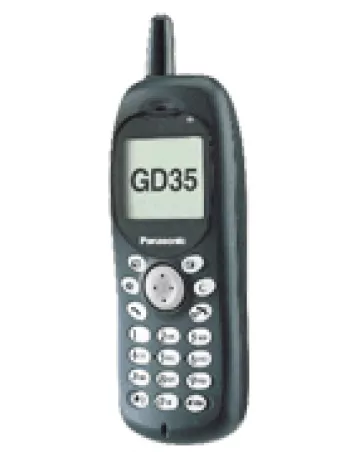
Overview and Introduction
The Panasonic G60, announced in the third quarter of 2003, is part of a lineage of mobile phones that were produced during a time of significant technological transition. While smartphones today dominate the market with advanced features and capabilities, devices like the Panasonic G60 offered simplicity and core communication features that catered to the needs of users during its time. With a build that reflects the early 2000s design ethos, the G60 was a choice for users seeking a reliable mobile phone experience without the complexities of modern smartphones.
Design and Build
The Panasonic G60 sports dimensions of 104 x 47 x 19 mm, making it compact and suitable for easy handling. Weighing only 87 grams, it is lightweight, which adds to its portability, a key aspect for devices during this era. The device’s mini-SIM form factor was typical of phones during its time, accommodating a mini-SIM card for connectivity. A notable design element is its chrome metal color, which gives it a classic appearance, aligning with the early aesthetic choices for electronics.
Display Features
Panasonic G60 features a CSTN display capable of showing 4096 colors. The resolution is set at 128 x 128 pixels, allowing for a clear and sufficiently bright screen experience, though it is far from what is achievable with modern displays. The choice of CSTN technology reflects the technological standards of the time, providing essential display capabilities for basic phone functionalities like dialing, messaging, and playing simple games.
Network and Connectivity
As a GSM device, the Panasonic G60 supports GSM 900/1800 networks. This dual-band capability was adequate for coverage in many regions where GSM services were prominent during the early 2000s. The inclusion of GPRS Class 8 technology allowed for basic data connections, but more advanced connectivity options like EDGE or 3G were not present. Notably, connectivity features like Bluetooth, USB, and WLAN were omitted, which aligns with its focus as a feature phone for calls and texts.
Memory and Storage
The storage capabilities of the Panasonic G60 reflect its status as a feature phone. It does not support external storage card slots, emphasizing its role for primary functions. Users had access to a phonebook capable of storing 200 entries across three fields and call records for ten dialed, received, and missed calls. This limited storage was sufficient for users focusing on essential communication tasks without the need for additional data storage.
Battery Life and Performance
Equipped with a removable Li-Ion 740 mAh battery, the Panasonic G60 provided robust battery life for its users. Offering up to 250 hours of standby time and up to 5 hours of talk time, it highlighted the efficiency of feature phones in power consumption. The focus was on reliability and ensuring users could have long periods between charges, a crucial factor given the limited charging options available while on the go.
Messaging and Communication
The G60 came with basic yet necessary messaging capabilities, supporting SMS, EMS, and MMS. These features allowed users to send and receive text messages, along with multimedia messages to a certain extent. While email functionality was missing, the inclusion of a WAP 1.2.1 browser facilitated basic mobile internet browsing. Communication methods were straightforward, aligning with the needs of users seeking basic connectivity options.
Sound and Alert Features
The device did not feature a loudspeaker, opting instead for vibration and downloadable polyphonic ringtones to alert users. The lack of a 3.5mm audio jack reflects its primary focus on being a communication tool rather than a media consumption device. These choices reiterated the phone’s emphasis on providing a straightforward communication experience without the distraction of more complex multimedia features.
Additional Features
In line with other feature phones, the Panasonic G60 included basics such as an alarm clock and a selection of simple games like Black Jack. The absence of Java support limited its ability to run third-party applications, retaining user focus on its core functionalities. This lean feature set ensured that the phone remained user-friendly, catering to those who were not looking for the added complexity of more modern operating systems.
Conclusion
The Panasonic G60 exemplifies a period in mobile phone history where devices were built to meet fundamental communication needs. It offered reliability, an efficient battery life, and basic features that were well-suited for the early 2000s. While it has been discontinued and technological advancements have dramatically shifted the mobile phone landscape, the G60 serves as a reminder of an era where simplicity and functionality were at the forefront of mobile device design.
Main Features of Panasonic G60
- Compact Design: Dimensions of 104 x 47 x 19 mm and a lightweight of 87 g.
- Display: CSTN screen with 4096 colors and a resolution of 128 x 128 pixels.
- GSM Technology: Supports GSM 900 / 1800 bands.
- Messaging Capabilities: Supports SMS, EMS, and MMS.
- Polyphonic Ringtones: Downloadable ringtones with a composer feature.
- Games: Includes a built-in Black Jack game.
- Battery Life: Removable Li-Ion 740 mAh battery offering up to 250 hours standby and 5 hours talk time.
Drawbacks of Panasonic G60
- Only supports GSM 2G bands with no EDGE support.
- Discontinued product, no longer available in the market.
- CSTN display with only 4096 colors and low resolution.
- No memory card slot for expandable storage.
- Limited phonebook capacity (200 entries) and call records.
- No camera feature available.
- No loudspeaker or 3.5mm audio jack for external audio.
- Lack of modern connectivity options such as WLAN, Bluetooth, and USB.
- No built-in positioning or radio functionality.
- Limited to basic messaging and internet browsing (WAP 1.2.1).
- No support for Java-based applications.
- Basic battery capacity, offering limited talk and standby time.

View Also
More Phones
All Rights Reserved +14266 Phones © Mobilawy 2025
























